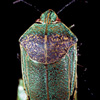
 GOOD GUYS & BAD GUYS
GOOD GUYS & BAD GUYS 

 |
 GOOD GUYS & BAD GUYS
GOOD GUYS & BAD GUYS 
|
 |
[Good Guys & Bad Guys Home | About This Site | Card List | HBS Home | Bishop Museum Home
BAD GUY  |
||
 |
24.
Small Indian Mongoose / manakuke
Scientific name: Herpestes javanicus Classification: Phylum: Chordata. Class: Mammalia. Family: Viveridae Origin: Introduced Status: Common in fields and lowlands Distribution: O`ahu, Maui, Moloka`i, Big Island Sound file: -- Map: -- Most of us have seen those long, thin, light brown, weasel-looking creatures run across the roads in front of our cars, then quickly disappearing into a bush or long grass. They are mongooses and they are mean and nasty killers. The mongoose was introduced in 1883 to control rats in sugar cane fields. Although the intentions of its introductions were good, the mongoose has instead proven to be a persistent threat to our native wildlife. The myth that introducing the mongoose was a failed biological experiment because rats were nocturnal and mongooses were diurnal is not quite correct. It was actually an excellent cane field ratter, but it did not stay put in the lowland cane fields, and eventually wandered into other lowland areas and upland forests where it searched for food that was easier to get. This food included insects, other small animals, and eggs. Although insects make up a large part of its diet, the mongoose is a serious enemy of native animals because it preys on ground-nesting birds and their eggs, such as seabirds and the nene. Since there are no predators to control its numbers, the mongoose continues to pose problems throughout the islands (fortunately it is not present on Kaua‘i or Lana‘i) and its predacious lifestyle has led to the reduction in populations and even possibly the extinction of some of our native birds. |
|
| Photo courtesy U.S. Fish & Wildlife Service | ||